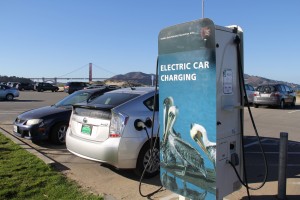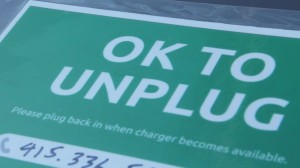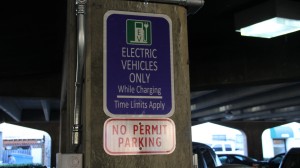[youtube]0GzQumYXsH0[/youtube]
Dimitrios Papadogonas, a vice president of marketing at Silicon Valley-based ChargePoint, was sitting in the governor’s office not long ago when he received an alert on his mobile phone.
It was from his company’s own app, letting him know that a stranger had unplugged Papadogonas’s electric vehicle parked two blocks away in a public garage.

“I was unplugged for no reason whatsoever. No reason. They didn’t plug in their car — they just unplugged me,” Papadogonas says. “No note!”
As of September, there were roughly 11,500 plug-in electric vehicles in the Bay Area. They come with standard owner manuals, but no Emily Post books on “EV Charging Etiquette.” Meanwhile, electric vehicle charging stations are multiplying at a fast rate across San Mateo and Santa Clara counties.
So, call these next-level first-world problems, but complaints like Papadogonas’s aren’t isolated. Though almost cultish in their support of the electric car community, EV owners are bristling at being unplugged or having to unplug other idle, fully charged cars. Even worse is finding their spots snatched up by non-EV drivers.
Compounding the problem, industry insiders say, is a lack of standardization when it comes to the indicator lights that let people know the car doesn’t need any more juice.
Some feel there’s an implicit hierarchy involving non-EVs, hybrid EVs and “pure” EVs. Non-EV drivers shouldn’t ever park in charging spots, they say, whereas hybrid drivers could always “top off” at a regular ol’ gas station.
“Please don’t park your MS in an EVSE parking spot unless you need to charge,” a online commenter pleaded in a Tesla-related forum last month, referring to Tesla’s Model S. “On several occasions I’ve seen an MS taking up an EVSE parking spot without charging. I even informed a MS owner that it was discourteous…his response was, ‘but these are the best parking spots.’”
Forrest North, a former Tesla engineer and the chief operating officer of EV-software company Recargo, says he often hears stories like these – or experiences such incidents himself.
“I’ve been to this exact station and seen a brand-new Leaf, and on another day a brand-new Volt, parked in this spot and not plugged in,” he says, gesturing to an electric charging station in a parking garage on California Avenue in Palo Alto.
“That would be like parking in front of a gas station that’s completely full and you just park there and go inside to get some jerky or a sandwich, while there’s a line of people waiting to use it.”

While it’s unclear how many EV charging stations are up and operational on the Peninsula alone, Papadogonas of ChargePoint says there are more than 2,000 stations across the Bay Area, and that the year-over-year growth rate is around 70 percent.
Some are public stations, such as the one on California Avenue. Others are technically private, like the ones sponsored by local tech companies to attract and retain employees. And there are countless other charging options at private residences — as some people open up their home station to the general EV public by listing their address on sites like Recargo‘s Plugshare.com.
Many of these stations are free to use. But even if you’re getting charged to charge, the cost is usually nominal compared with filling up a gas tank: A recent report from the Santa Clara County Department of Planning and Development estimates that charging a purely electric vehicle enough for a 100-mile trip would cost $3.74, compared with $13.36 for the same trip made by a gas-fueled compact sedan.
So it’s often not the cost, but the time it takes to charge, that lends itself to potentially impolite behavior. Charging stations consist of Level 1 chargers (110- to 120-volt outlets comparable to basic home outlets), slightly more powerful Level 2 chargers or Level 3 fast chargers.
Depending on the vehicle’s range and the type of charger the owner plugs into, charging up an EV can take as little as 15 minutes or as long as several hours, which means it can be hard to know when it’s okay to unplug someone else and when it’s not.
Issues like these have spurred EV bloggers to post etiquette tips online. Brad Berman, a writer and researcher at Recargo-owned Plugincars.com, offered some tips this past summer in a comprehensive post, including: “Charge only when necessary,” “Don’t unplug plug-in hybrids,” and “No nasty notes.”

But Marc Geller, a writer and advocate alongside Berman at Plugincars.com who focuses mostly on policy around EVs, dismisses the notion that some display poor etiquette at charging stations. He says he’s never encountered any overtly bad behavior.
Still, Geller carries with him a green laminated sign that displays his full phone number underneath text that reads: “Okay to Unplug.” He leaves this sign on the dashboard in his car when it is, in fact, okay to unplug.
Others have no qualms in being the “unplugger” themselves. Robert Olson, an Oakland resident who drives a relatively rare Honda Fit EV, says before he unplugs a stranger’s car he usually looks to see if there are hybrids he could unplug first, or the cars are fully charged.
“Most people don’t mind if you unplug a full vehicle, because they understand that charging stations are limited,” Olson says.
Plus, EV owners have one option that gas guzzlers don’t: They can charge up at home, which the majority of them do.
Recargo, along with PlugInsights, just released survey results that show the overwhelming majority of EV charging (more than 80 percent) takes place at home, with only 10 percent of EV drivers using public charging on a monthly basis. Tesla Model S drivers are especially likely to charge at home, the data show.
In Palo Alto, an ordinance was passed in September requiring every new single-family home to come pre-built for electric vehicle chargers.
But the PlugInsights report also notes that as availability of Level 3 fast chargers in public places expands, the amount of public charging is expected grow, too.
Assuming public charging does grow, EV drivers and non-EV drivers alike might want to keep in mind a common adage: Mind your manners.
